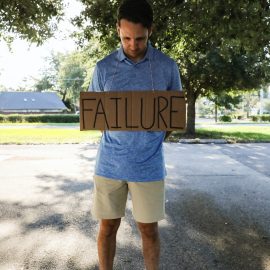

This article is an excerpt from the Shortform book guide to "The Happiness Trap" by Russ Harris. Shortform has the world's best summaries and analyses of books you should be reading.
Like this article? Sign up for a free trial here .
What is committed action in ACT? What does it mean to act with commitment?
Committed action is the final principle in Acceptance and Commitment Therapy (ACT). Committed action happens when we consistently take actions that align with our values—even when we fail. This final principle will give you all the tools you need to achieve psychological flexibility, enabling you to adapt to difficult situations and take effective action to build a rich and meaningful life.
Keep reading to learn about the two components of committed action: fortitude and commitment.
Element #1: Fortitude—Accepting the Unpleasant
Harris defines fortitude as accepting that effective action comes with unwanted side effects, such as negative thoughts, feelings, and urges. Fortitude doesn’t necessarily imply that we enjoy or welcome these side effects—uncomfortable thoughts and feelings are difficult, maybe impossible, to enjoy. However, fortitude does mean being fully present in our lives even when we don’t enjoy the thoughts and feelings we’re experiencing.
We all must practice fortitude to engage with society. For instance, when we buy food, spending money is an undesired side effect—but it’s one that we’re willing to accept.
Fortitude is also necessary to live a meaningful life. When we confront an obstacle, we either practice fortitude to deal with it or we don’t. If we don’t practice fortitude, then we close ourselves off to the possibilities of life. If we practice fortitude, we can overcome that obstacle even if it causes us pain.
| The 4 C’s of Mental Toughness The idea of mental fortitude, or toughness, is a loaded term in American culture. You can find hundreds of people trying to sell their own particular brand of mental toughening online—and almost none of these align with what Harris proposes in The Happiness Trap. One of the most common models for mental fortitude is called the 4 C’s of mental toughness: 1) Control your emotions and your life circumstances. By contrast, Harris’s model emphasizes that our emotions are entirely outside of our control, and that all we can do is to manage them. 2) Commitment is the ability to set and achieve goals consistently. While goal-setting is also part of Harris’s model, ACT emphasizes that these goals must align with your values. 3) Challenge means seeking the highest possible challenges for yourself and adapting quickly to adversity. While ACT doesn’t specifically advocate seeking challenges, it does hold that challenges are opportunities for growth. 4) Confidence is your belief in yourself and your ability to influence others. ACT doesn’t promote self-esteem, which stems from your thinking self judging you to be worthy, but rather self-acceptance, which grows from connection with your observing self. . |
Element #2: Commitment—Persevering Despite Failure
While fortitude is accepting the undesirable side effects of effective action, commitment is accepting that failure is inevitable, while also knowing that no failure is final.
For example, most people have been speaking since they were toddlers, and yet no one speaks so perfectly that they do not occasionally stumble over a word in a sentence. Without commitment, we would take that failure as final: an unavoidable sign that our efforts to speak without mistakes are doomed, and so we might as well stop speaking.
In the context of ACT, Harris says that commitment means continuing to pursue effective action even if you sometimes fail to meet your goals. The emphasis on commitment is important because we can’t know whether we’ll ever actually accomplish any specific goal we set for ourselves. Only by pursuing effective action regardless of whether we succeed or fail can we continue to act effectively.
Every time we fail to meet a goal, we have the opportunity to practice commitment. ACT emphasizes that you can treat any problem as an opportunity for personal growth. The alternative is to fall back into the happiness trap: When we struggle to come to terms with our failures, we generate more negative thoughts and emotions.
In ACT, committed action is a three-step process:
- Recognize and fully accept your situation. This can involve the mindfulness techniques of defusion, expansion, and connection.
- Ask yourself what action you can take now that connects with your values.
- Take the action you’ve decided on. Sometimes, there won’t be an immediate action you can take; this is when you can practice the “acceptance” portion of ACT with defusion, expansion, and connection.
Sometimes commitment alone isn’t enough, and you must recognize that the actions that you’re taking aren’t having a meaningful impact on a situation. For instance, if you’re trying to hammer a nail with a piece of rope, the problem isn’t your commitment—you need the awareness to grab a hammer when you need one. In order to have this kind of awareness, rely on your mindfulness skills to connect to the situation.
| Commitment Requires Grit Grit is a similar concept to what Harris calls commitment. In Grit, Angela Duckworth emphasizes that grit is a combination of passion and perseverance, and she defines perseverance as Harris defines commitment: having the resilience to overcome setbacks and work hard to finish. Here are five ways to embody grit: 1) Shift your perspective. Failure is an inevitable part of life, and it doesn’t have to be negative—instead, it’s an opportunity to try again, or try something different. 2) Don’t bother trying to be perfect. One reason failure can be so difficult to stomach is that it challenges the idea that we can be flawless. Instead, let go of that ideal, develop humility, and try again. 3) Get used to living outside of your comfort zone. Failures lead us to circumstances that feel foreign or uncertain. When you accept this discomfort, you’ll find even more opportunities to learn from your mistakes. 4) Don’t be afraid to seek support. While Harris emphasizes an individualistic approach to escaping the happiness trap, you don’t have to face failure alone. Lean on your support system—they may even offer unexpected lessons. 5) Focus on your goals. Failure doesn’t mean that you have to abandon your goals. You may simply need to try again—or try a new strategy. |

———End of Preview———
Like what you just read? Read the rest of the world's best book summary and analysis of Russ Harris's "The Happiness Trap" at Shortform .
Here's what you'll find in our full The Happiness Trap summary :
- Why trying to be happy is making you unhappy
- How to practice ACT, or Acceptance and Commitment Therapy, to become happier
- How to develop “psychological flexibility” toward negative feelings instead of eliminating them






